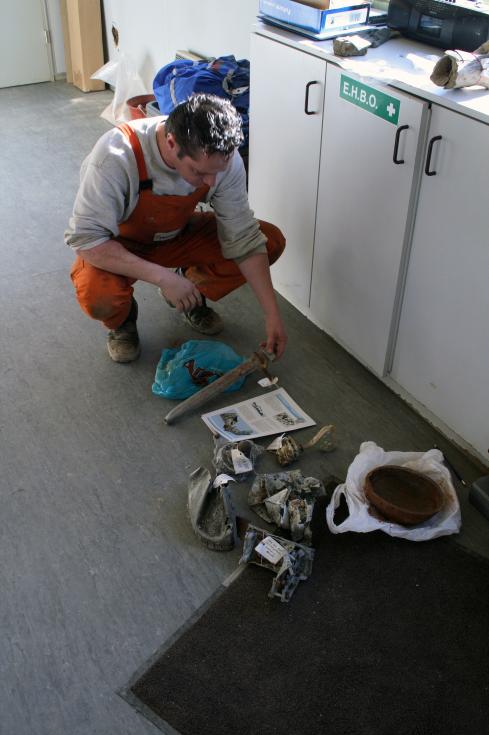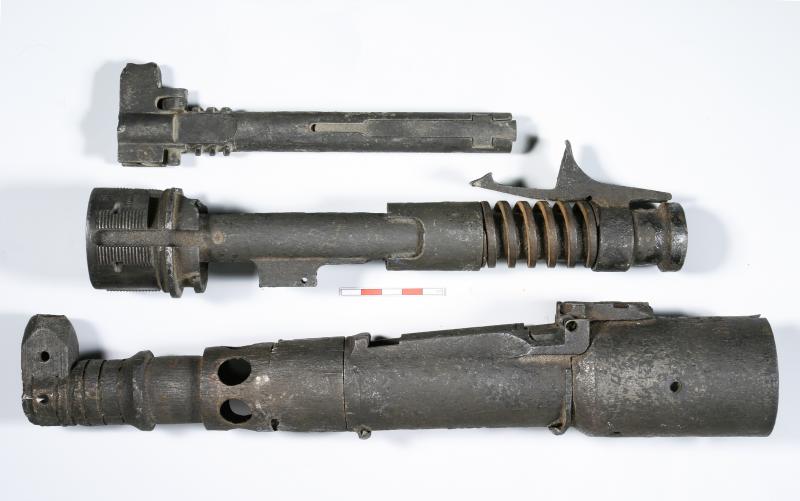The BMAPA/English Heritage Finds Protocol applies to aggregates dredged from UK waters and landed on the Continent. Following a number of useful reports, the ALSF Protocol Awareness Programme has been extended across the North Sea to Holland and Belgium.
It was my job to visit aggregate wharves in Antwerp, Flushing and Amsterdam to give dredging company staff an opportunity to see samples of finds already made from dredging activities, including a mammoth leg bone, cannonballs and aircraft parts. The visits also provided advice to staff on what sort of finds they can expect from dredged aggregates, how to conserve fragile finds and how to report anything of interest.  I got more than I bargained for when Paul Verheul at Hanson's Flushing wharf made a quick dash home and returned twenty minutes later with a large machine gun. Had I unwittingly insulted our Dutch hosts with my poor language skills? Fortunately, I had managed to avoid an offensive language blunder, and the machine gun was just one of many new finds that came to light from the continental visit. The MG 15 machine gun was a common armament on Luftwaffe aircraft at the onset of WWII, and it seems likely this gun came from a German aircraft lost over the North Sea, perhaps quite early in the war. Unfortunately, the gun was found over 5 years ago, before the reporting scheme had begun, so its exact finding place is not clear.
I got more than I bargained for when Paul Verheul at Hanson's Flushing wharf made a quick dash home and returned twenty minutes later with a large machine gun. Had I unwittingly insulted our Dutch hosts with my poor language skills? Fortunately, I had managed to avoid an offensive language blunder, and the machine gun was just one of many new finds that came to light from the continental visit. The MG 15 machine gun was a common armament on Luftwaffe aircraft at the onset of WWII, and it seems likely this gun came from a German aircraft lost over the North Sea, perhaps quite early in the war. Unfortunately, the gun was found over 5 years ago, before the reporting scheme had begun, so its exact finding place is not clear.  Happily, many of the new finds have been traced to specific aggregate areas, including a sixteenth century coin, boat and ship fittings, a British aicraft part, two anchors and numerous mammoth teeth. Wessex Archaeology, who run the reporting scheme for English Heritage and the British Marine Aggregate Producers Association, are looking forward to seeing what else will turn up from participating wharves on the Continent, now that the wharf staff have promised to keep their eyes peeled for more finds.
Happily, many of the new finds have been traced to specific aggregate areas, including a sixteenth century coin, boat and ship fittings, a British aicraft part, two anchors and numerous mammoth teeth. Wessex Archaeology, who run the reporting scheme for English Heritage and the British Marine Aggregate Producers Association, are looking forward to seeing what else will turn up from participating wharves on the Continent, now that the wharf staff have promised to keep their eyes peeled for more finds.
 Happily, many of the new finds have been traced to specific aggregate areas, including a sixteenth century coin, boat and ship fittings, a British aicraft part, two anchors and numerous mammoth teeth. Wessex Archaeology, who run the reporting scheme for English Heritage and the British Marine Aggregate Producers Association, are looking forward to seeing what else will turn up from participating wharves on the Continent, now that the wharf staff have promised to keep their eyes peeled for more finds.
Happily, many of the new finds have been traced to specific aggregate areas, including a sixteenth century coin, boat and ship fittings, a British aicraft part, two anchors and numerous mammoth teeth. Wessex Archaeology, who run the reporting scheme for English Heritage and the British Marine Aggregate Producers Association, are looking forward to seeing what else will turn up from participating wharves on the Continent, now that the wharf staff have promised to keep their eyes peeled for more finds.